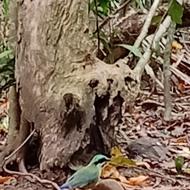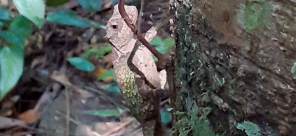Birds of Vietnam, Bird Species in Vietnam

Let's join AdventureGreen on our bird quests to learn about the different birds and bird species in Vietnam. Here you can find out more about the birding spots that these bird species are found.

- Order: Passeriformes
- Family: Pittidae
Pitta is a genus of birds in the Pittidae, or pitta family.
"Pitta" means "small bird", "pretty", "bauble" or "pet" in the Telugu language of southern India.
The term refers to a family of birds, often called pitta birds, which are known for their colorful plumage, short tails, and tendency to forage for insects on the forest floor.
1/ Blue-winged pitta (Pitta moluccensis, Đuôi cụt cánh xanh)
- Order: Passeriformes
- Family: Pittidae
- Genus: Pitta
Blue-winged pitta
(Pitta moluccensis, Đuôi cụt cánh xanh)
The blue-winged pitta (Pitta moluccensis) is a passerine bird in the family Pittidae.
The blue-winged pitta is regularly found in Brunei, Cambodia, China, India, Indonesia, Laos, Malaysia, Myanmar, the Philippines, Singapore, Thailand, and Vietnam.
"Pitta" means "small bird", "pretty", "bauble" or "pet" in the Telugu language of southern India.
The term refers to a family of birds, often called pitta birds, which are known for their colorful plumage, short tails, and tendency to forage for insects on the forest floor.
moluccensis Moluccas Islands (now Maluku Islands) in eastern Indonesia.
- Order: Passeriformes
- Family: Pittidae
- Genus: Pitta
Fairy pitta (Pitta nympha)
Đuôi cụt bụng đỏ
Other names: lesser blue-winged pitta, Chinese pitta, little forest angel, and eight-coloured bird.
The fairy pitta (Pitta nympha) is a small and brightly colored species of passerine bird in the family Pittidae.
The fairy pitta breeds in East Asia and Northeast Asia (April-September), and migrates south to winter in South and Southeast Asia (October-March).
"Pitta" means "small bird", "pretty", "bauble" or "pet" in the Telugu language of southern India.
The term refers to a family of birds, often called pitta birds, which are known for their colorful plumage, short tails, and tendency to forage for insects on the forest floor.
The specific epithet nympha is from the Latin word nympha, meaning nymph.
- Order: Passeriformes
- Family: Pittidae
- Genus: Pitta
Western hooded pitta (Pitta sordida)
Đuôi cụt mào
The western hooded pitta (Pitta sordida) is a passerine bird in the family Pittidae.
The bird species is common in eastern and southeastern Asia and maritime Southeast Asia.
Traits:
- Black-headed;
- Brown cap (reddish-browned cap);
- Red-vented;
- Shiny blue-wing patch;
"Pitta" means "small bird", "pretty", "bauble" or "pet" in the Telugu language of southern India.
The term refers to a family of birds, often called pitta birds, which are known for their colorful plumage, short tails, and tendency to forage for insects on the forest floor.
In Latin, "sordida" is the feminine nominative singular form of the adjective sordidus, meaning dirty, unclean, foul, filthy, vulgar, low, base, mean, paltry, or vile. sordere to be dirty, sordes dirt.
The English word "sordid" shares the same roots and meanings.
- Order: Passeriformes
Pittas are a family, Pittidae, of passerine birds found in Asia, Australasia and Africa.
"Pitta" means "small bird" in the Telugu language of southern India.
The term refers to a family of birds, often called pitta birds, which are known for their colorful plumage, short tails, and tendency to forage for insects on the forest floor.
- Order: Passeriformes
- Family: Muscicapidae
Calliope is a genus of passerine birds in the Old World flycatcher family Muscicapidae.
Previously placed in the genus Luscinia.
1/ Siberian rubythroat (Oanh cổ đỏ, Calliope calliope)
2/ Blackthroat (Calliope obscura), also known as the black-throated robin or black-throated blue robin
The genus Calliope name from classical Greek meaning beautiful-voiced.
- Order: Passeriformes
The family Cisticolidae is a group of about 160 warblers, small passerine birds found mainly in warmer southern regions of the Old World.
Formerly included within the Old World warbler family Sylviidae.
The name Cisticoladae from Cisticola, which is from Ancient Greek kisthos, "rock-rose", and Latin colere, "to dwell". ... cisticola).
- Order: Passeriformes
- Family: Muscicapidae
- Genus: Cinclidium
Blue-fronted robin
(Oanh mày xanh, Cinclidium frontale)
The blue-fronted robin (Cinclidium frontale) is a species of bird in the family Muscicapidae.
The bird is found in Bhutan, China, Northeast India, Laos, Thailand, Vietnam, and possibly Nepal.
Cinclidia from Latin cinclus thrush (Greek kinklos unknown waterside bird).
frontale, frontalis Latin frontalis fronted, browed (> Latin frontalia or frontale frontlet > frons, frontis forehead, front).
- Order: Passeriformes
- Family: Muscicapidae
Cinclidium is a genus of the family Muscicapidae.
1/ Blue-fronted robin (Oanh mày xanh, Cinclidium frontale)
Cinclidia from Latin cinclus thrush (Greek kinklos unknown waterside bird).
- Order: Passeriformes
- Family: Muscicapidae
Myiomela is a genus of bird in the family Muscicapidae. Some members have sometimes been included in the genus Cinclidium and the phylogeny has not been resolved completely.
Myiomela : Greek word muia – fly; melo – to take an interest in.
1/ White-tailed robin (Oanh đuôi trắng, Myiomela leucura)
Specific epithet is from Ancient Greek λεύκουρος (leúkouros, “white-tailed”).
- Order: Passeriformes
- Family: Muscicapidae
- Genus: Tarsiger
Red-flanked bluetail
(Tarsiger cyanurus, Oanh đuôi cụt lưng xanh), also known as the orange-flanked bush-robin
The red-flanked bluetail (Tarsiger cyanurus), also known as the orange-flanked bush-robin, is a small passerine bird of the Old World flycatcher family, Muscicapidae.
The bird is a migratory species breeding in northern Asia and northeastern Europe, from Finland east across Siberia to Kamchatka and south to Japan.
The species winters mainly in southeastern Asia, in the Indian Subcontinent, the Himalayas, Taiwan, and northern Indochina.
The genus name is from Ancient Greek tarsos, "flat of the foot" and Latin gerere, "to carry".
cyanura, cyanurus Greek kuanos dark-blue; -ouros -tailed (oura tail).
- Order: Passeriformes
- Family: Muscicapidae
- Genus: Tarsiger
Himalayan bluetail
(Tarsiger rufilatus), also called the Himalayan red-flanked bush-robin or orange-flanked bush-robin
The Himalayan bluetail (Tarsiger rufilatus) is a small passerine bird of the Old World flycatcher family of Muscicapidae.
The genus name is from Ancient Greek tarsos, "flat of the foot" and Latin gerere, "to carry".
rufilatus Latin rufus red; latus flank, side.






































